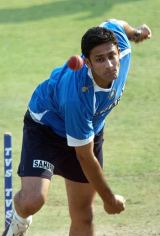It is said that the memory span of the average Indian fan is one week,
perhaps less. In Anil Kumble's case, that may not be such a bad thing.
The last ball he bowled in one-day cricket was a quintessential Kumble
rocket. Bermuda's Malachi Jones stood stupefied - and better batsmen
have suffered similarly - as the ball pitched in line, hurried
inexorably on, and crashed into pad, trapping him plumb in front.
That's the kind of ball Kumble should be remembered by.
Kumble, who announced his retirement from the one-day game today, has
not been India's first choice spinner for a while now. But the last
few years of his career should not obscure the fact that he was once a
one-day bowler who was next to impossible to attack - captains
routinely bowled him inside the first fifteen overs when a fast bowler
struggled, and then at death - and even harder to counter defensively.
If you let him push you back, it was only a matter of time before he
nailed you.
The 6 for 12 in the final of the Hero Cup should burn as brightly in
mind as the torches that 100,000 Kolkatans held aloft
at the Eden
Gardens when India won. It should slip no one's attention that he was
the top wicket-taker in the 1996 World Cup, outperforming Shane Warne
and Muttiah Muralitharan in the subcontinent.
Just statistically, the evidence is staggering. Till October 20, 2000,
he had played 208 ODIs, picking up 274 wickets at an average of 28.56,
conceding just 4.20 runs per over. Then, playing against Sri Lanka
in Sharjah, he suffered a rotator cuff injury to his right shoulder.
Careers have been ended by lesser setbacks. There were suggestions
then that he would never play international cricket again, and even if
he did, that he would never be the bowler that he was. That's
partially true.
Kumble spent 339 days in surgery, post-operative care, physiotherapy
and rehabilitation, mentoring bowlers from the sidelines with one hand
in a sling, till he returned to action against South Africa
at Johannesburg on
October 5, 2001. From then to now, in the unequal second half of
Kumble's career, he has played 63 ODIs taking only a wicket a game, at
an average of 41.03.
It's not surprising then, that Kumble has been in and out of the
eleven since that setback. Through further aggravation of the injury,
dips in performance or withdrawing himself from series, Kumble has
missed an astounding 107 of the 170 matches India has played since
then. In that sense, it has been a career of two parts for Kumble. The
second, with the unflattering ODI figures, is when he had all but lost
his flipper. It was when the pace and zip had reduced just enough to
take him from being lethal to merely threatening.
But Kumble the person, just like Kumble the bowler, is not the sort
who gives up. He re-invented himself, bowling slower through the air,
tossing the ball up more, finding a subtler googly to go with his
telegraphed one - little finger pointing in the air like an antenna.
He came round the wicket more. And all this worked magnificently in
Test cricket. Happily, it coincided with a phase where India's batsmen
were finally putting decent scores on the board overseas, which gave
Kumble a chance to do his thing, and refute the charge that he was a
home-track bully.
Michael Atherton wrote that there were times when he sensed that
Curtly Ambrose, his nemesis, was going to bowl a yorker, and shaped to
play accordingly, only to find his off stump flattened anyway.
With Kumble at his best, it was much the same. Like some natural
disasters, you could forecast and predict all you liked but, when the
strike came, there was nothing to do but run for cover.
When he took all ten Pakistani wickets in an innings in that famous
Delhi Test in 1999, the civic authorities in Bangalore promised to
name a street after him; they settled for a traffic junction, calling
it Anil Kumble Circle. Now, as he calls time on his one-day career,
his achievements in the blue shirt should not be belittled just
because he has achieved so much more in whites.



